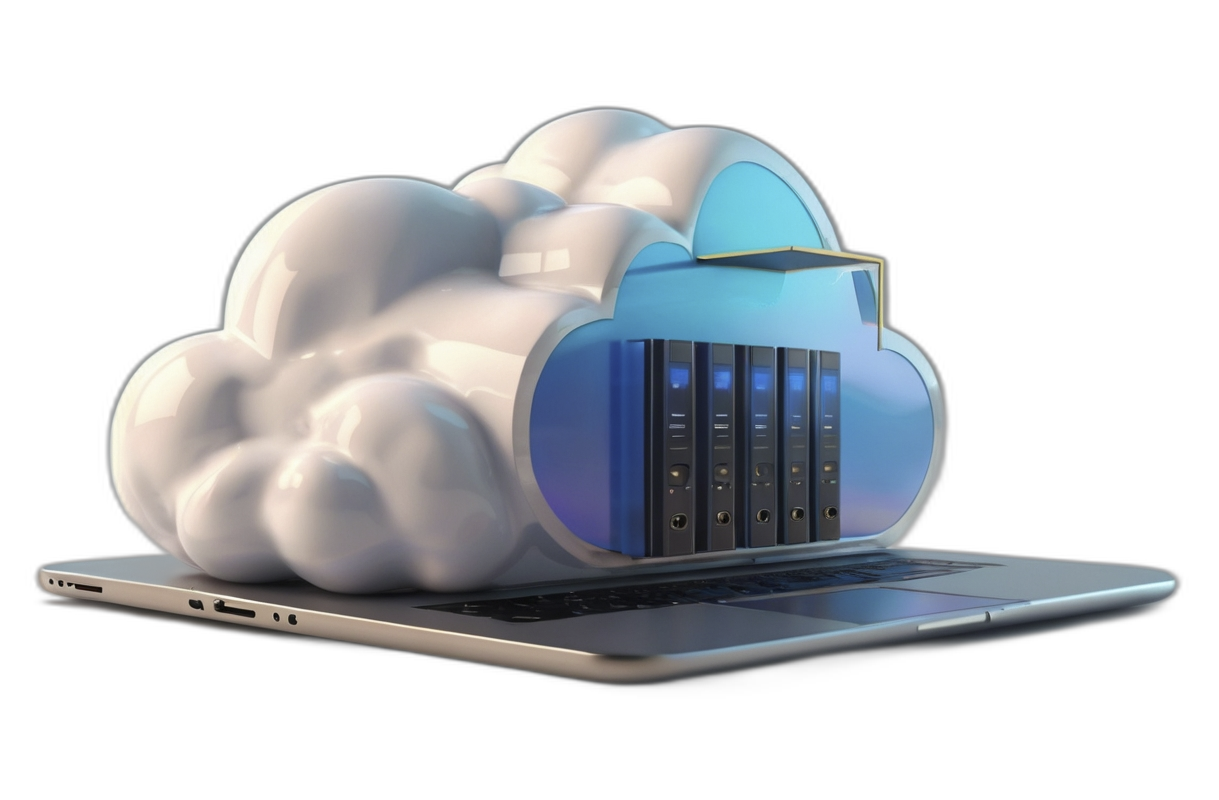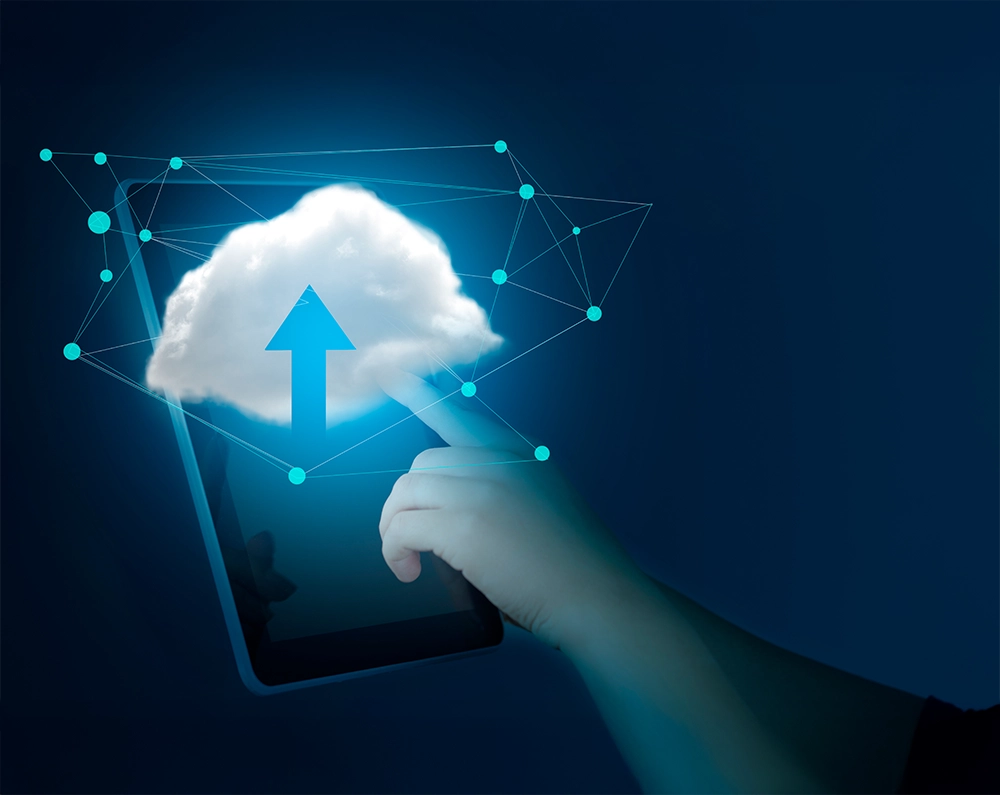

THE AUTHOR
Nishanth Gotte
Lead Consultant - Cloud
Digital transformation and cloud migration are two buzzwords that describe how business leaders look for effective ways to optimize their core business infrastructure. The significance of moving existing legacy applications to a cloud environment and enhancing them to attract and retain customers, push organizational development, improve operations, and stay competitive is continually increasing.
This year 70 percent of businesses are expected to accelerate investment in digital technologies, transforming current processes to optimize staff productivity, customer experience, as well as resiliency. Modernizing your legacy applications and systems helps to improve business performance and instill greater intelligence across the organization.
Failing to modernize your legacy applications can hold your business back from achieving sustainable growth:
- According to a study, holding on to legacy systems or applications in a bank can consume 78 percent of their IT budget. 70% percent of people stated that these old systems are an impediment to transformation and growth.
- Again, CIOs mention that 40% to 50% of their time is spent maintaining legacy systems, a barrier to better strategic plans.
- 65% of businesses will focus on modernizing legacy applications with broad, innovative technology platforms and venture capital through 2023.
Legacy applications, of course, can be extremely crucial to business operations, making a seamless cloud migration for application modernization imperative for your organization. Embracing cloud migration is a critical step in overcoming multiple challenges, as it enables your organization to enhance agility, scalability, and efficiency. Read this blog to learn more.
Common Pain Points of Legacy Applications
Legacy applications can cause challenges due to outdated technology, functionality, and architecture that hinder business value, user experience, performance, agility, and increase IT expenditure, adding to risk and complexity. Here are some common pain points:
- Challenging to update or maintain rising IT expenses regarding employees and time.
- Challenging and tiring to use.
- Code that is too long and sluggish on computer systems or hacked integrations can result in efficiency issues, bottlenecks, or uncertainty when it comes to scaling.
- Lengthy code in legacy applications makes it challenging for new IT employees.
- The legacy app might not interact with new systems.
- Third-party components of a legacy application may not be supported anymore.
- There are possible security threats and compliance issues.
- The application isn’t agile to changing customer requirements.
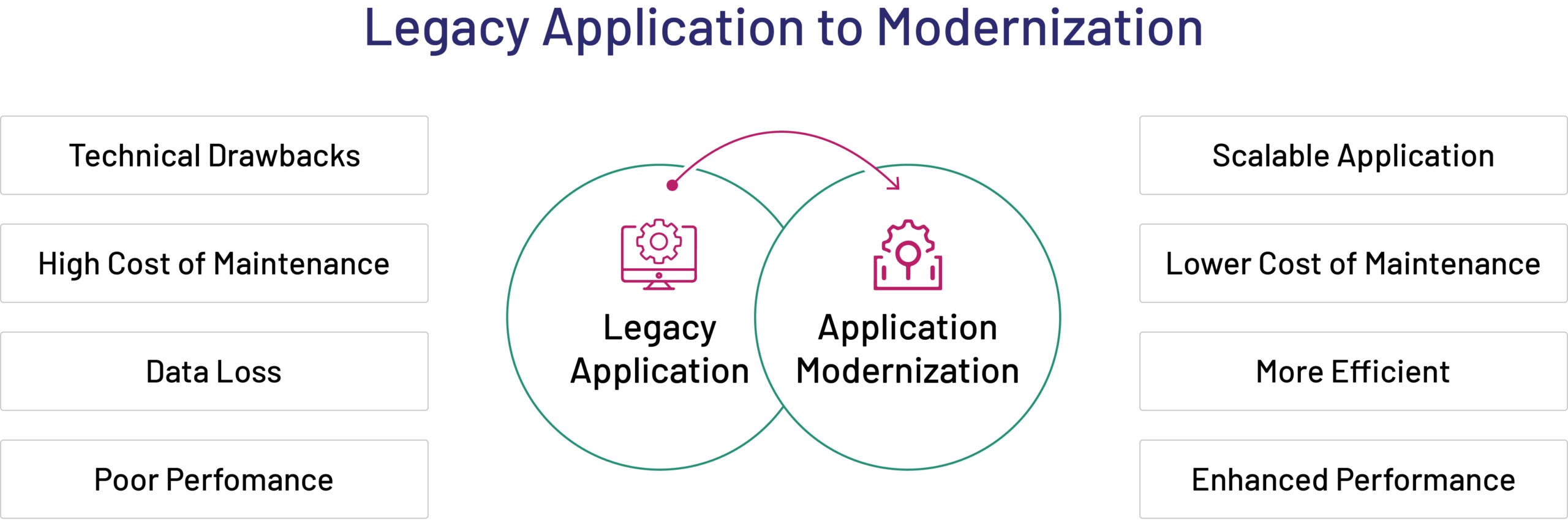
Why is Modernizing Legacy Applications a Necessity?
Forward-thinking businesses are adopting innovative thinking and methods around cloud migration and modernization. Here is why:
- 30% to 50% reduced application maintenance as well as operating expenditures
- 15% to 35% savings on infrastructure year over year
- 10% increase in application operational effectiveness
- 74% reduced costs on software, hardware, staff
- 14% improvement in yearly returns equating to $1 billion on average for big companies
Benefits of Application Modernization and Migration
Today, organizations want agile, smart, and intelligent business IT applications. Consequently, this implies an increasing necessity to migrate from legacy technologies to cloud solutions. It can seem like an overwhelming task but done well and with the right team, it is more than worth the effort. Making the jump to cloud technologies can transform traditional businesses. Let’s look at the enormous benefits of application modernization and migration:
Improve IT costs
Improve efficiency with agility and scalability
Gain useful insights
Optimize security and minimize risk
Innovate quickly
Build an agile and strategic workforce
Cloud Migration Strategies
The cloud migration process is unique to every organization, whether you choose Amazon Web Services, Microsoft Azure, or another provider. There is no single formula, even within an organization. Every application, piece of infrastructure, or database to be migrated is related to various computing, expenditure, complexity, security, and efficiency requirements. The difficulty of moving any given legacy applications depends on the current architecture, support model, licensing, and other investments related to your on-premises software and hardware.
Your plan for migrating to a cloud environment will vary based on the size and environment complexity. The basic steps to begin the process include:
Plan: Be clear on your reasons for pursuing a cloud migration and which approach to choose. Begin by evaluating your existing environment and assessing the requirements based on the application resource needs.
Choose your cloud environment: Next, determine what type of cloud model you need to implement. Whether you opt for the public, hybrid, private cloud, or multi-cloud, depends on which of these best suits your current as well as future requirements.
Move your applications and data: With proper planning, your cloud migration can be a smooth process, but be sure to also include a focus on security needs and preparing for data backup and retrieval.
Verify post-migration success: You can’t officially claim your cloud migration is effective without proof – the migration should work as anticipated. Korcomptenz’s cloud migration services and solutions can help identify and document the benefits of migration by assessing pre- and post-migration application efficiency from a technical and business standpoint, using a low-risk or secure test environment.
Korcomptenz’s Approach to Application Modernization
We have developed a proven and effective strategy for application modernization that supports low-cost incremental, low-risk modernization while delivering value at each phase of the process.
Assessment: Evaluation (Accept, invest, migrate or streamline, and estimate) of your application portfolio.
Application Migration:
- Optimum cloud configuration detection
- Migration of workload and testing
- Development and training of system administrators
- Monitoring and assistance for a flawless migration
Modernization:
- Containerization
- Conversion of microservices
- Re-architecting and rewriting
- Implementation of DevOps
Optimization:
- Operationalization
- Monitoring
- Innovation
- Optimization
Application Modernization Approach
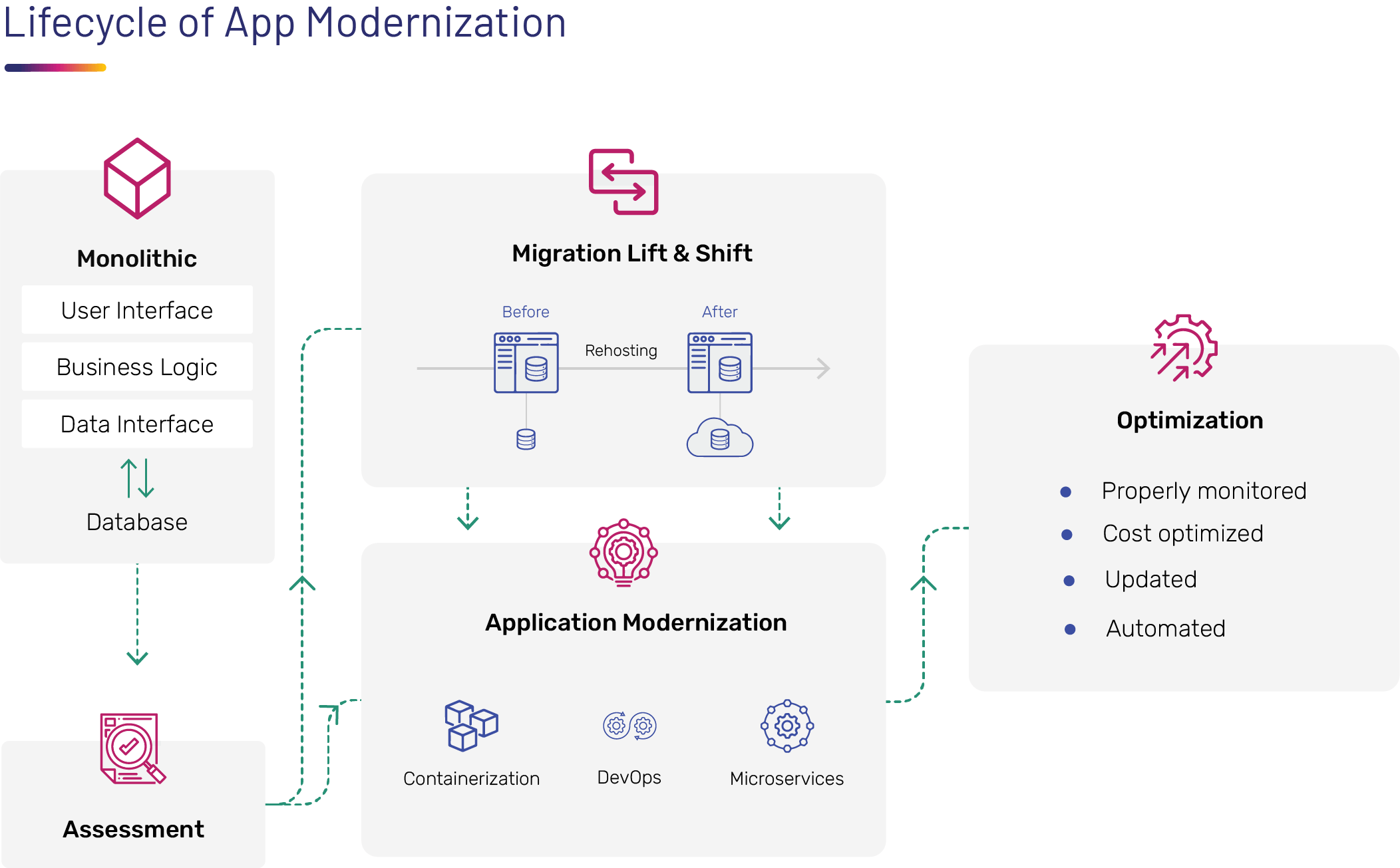
Application Modernization Path
Legacy applications often prove a major obstacle for companies undergoing digital transformation. Applications built on obsolete platforms employing older programming tools are challenging and inflexible to modify. However, innovative technologies and tools are emerging that help business leaders modernize their current applications and maintain system investments that are still significant for the company.
At Korcomptenz, our cloud experts look at the current trends in app modernization such as microservices, DevOps, Platform as a Service (PaaS), and more to figure out the essential role in application development best practices. By leveraging cloud migration services, companies can reduce infrastructure costs, achieve greater flexibility, and ensure easier maintenance and updates.
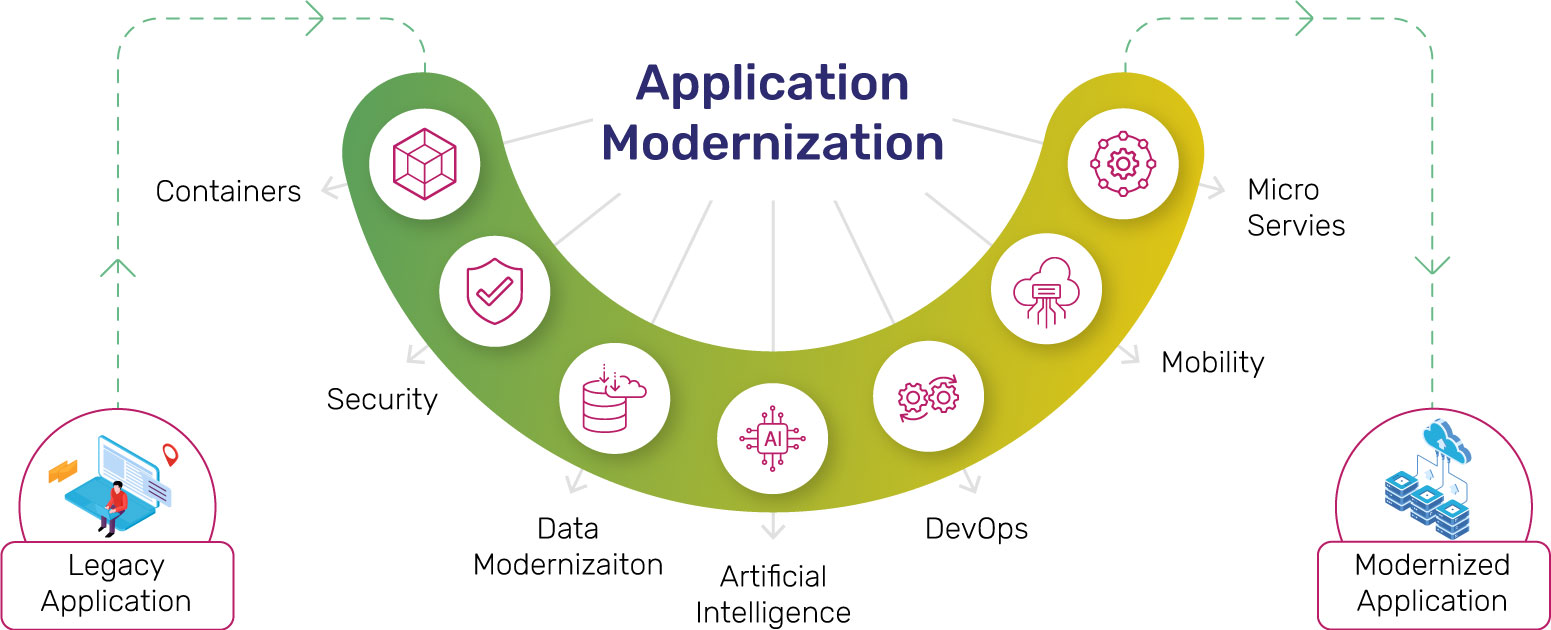
To overcome common challenges, here are six application migration strategies popularly called The 6Rs. They are Rehost – Lift and Shift, Replatform, Refactor, Repurchase, Retain, and Retire.
Our App Modernization Services
We delight customers with application modernization services that help cut back on cost, alleviate risks, boost agility, as well as create a unique user experience and new revenue streams.
Our all-inclusive services for your app modernization requirements include:
Consulting: We examine your legacy application architecture, infrastructure, and code, and then guide you on the enhancements to help your business gain maximum benefit from any preceding investments and meet new business needs.
Application Improvement: We ensure system re-design and re-architecture to increase stability, scalability, efficiency, and security.
Database Migration and Integration: Migrate from legacy databases to the current ones and build automated workflows to connect data from various sources.
Platform migration: We help clients migrate legacy applications/modules to an advanced platform, moving an on-prem app to the cloud.
Cloud is a major buzzword today and some clients have already migrated to AWS/Azure. Are you ready to take the leap of faith? Let’s have a look at the following scenarios:
Re-platforming mainframe with cloud
Re-platforming can help by migrating your current mainframe applications to open distributed systems, making it simpler to scale resources to meet user requirements.
Over time, organizations need to overhaul their software, adding features to an existing service to eliminate obstacles affecting your business’s capacity. This leads some companies to replace their mainframe with something new or completely rewrite applications, which can be a major strain on budgets.
Today, mainframes continue to support major applications in several businesses, providing software that is fundamental to their organization.
Modernize Mainframe Applications with a Hybrid Cloud Approach
To meet the ever-evolving demands of a digitally transformed company, customers are keen to modernize mainframe applications to improve agility, boost investment value, and modernize rapidly.
AWS Mainframe Modernization service lets customers streamline their workloads with their highly accessible and managed runtime environment.
You can adopt a cloud-native approach to build and modernize applications to improve agility and speed for enhanced productivity. Some customers choose a hybrid cloud strategy, blending on-prem and cloud services as needed.
How Customers Benefited from AWS Migrations
A popular GPS-supported navigation app that uses the location data of customers in real-time as well as user-proposed reports to recommend optimized routes.
Challenges: Though this application already migrated to the cloud, rapid expansion resulted in production challenges. The major pain points were:
- Bottlenecks
- Pushbacks
- Other complications
There was an urgency to look for a way to ensure feedback reached the users quickly while removing or alleviating production hassles.
Solution: The business chose to continue an active-active architecture through several cloud service providers, AWS and GCP to increase the flexibility of production systems.
A certain software platform was used by doctors, and medical professionals to handle their practices, safely and share data as well as oversee billing, workflow, and other duties.
Challenge: The platform had to be created new from its original company to function independently. So, all data had to be moved out of the original company’s data center. The challenges were:
- Protection of highly-sensitive patient information
- Access to data
- Security
Solution: The platform was already using the cloud data management services of a company and so, it was effortless to migrate the data to AWS.
How Customers Benefited from Leveraging Azure Migration and Modernization
Microsoft helped these customers with cloud migration and modernization:
A leading health organization in the US migrated to Azure that helped in:
- Reduction of CAPEx and technology, real estate costs
- Meeting customer needs quickly
- Creating a greater impact in fighting cancer
A popular pizza restaurant benefited by moving to Azure by
- Lowering its data recovery spend by 30 percent
- Reducing its data recovery time from 30 days to just a few hours by moving its data center and several branch offices to Azure
A major international airport thrived by migrating to Azure by:
- Cutting back on server costs by approximately 40 percent
- Fostering sustainability and environmental initiatives
A leading organization specializing in global education and cultural opportunities benefited by migration to Azure by:
- Speedy cloud migration
- Reduced disruption in education for students globally
A leading transport and logistics business was successful with Azure migration. Here is how:
- Migrated 200 servers saving money and data center racks and space
- Modernized all obsolete on-prem servers in just 7 months
Korcomptenz, a Microsoft Gold Certified Partner, can guide you through these cloud migration steps and ensure the success of your project regardless of the path you take.
The Korcomptenz Advantage
Korcomptenz’s enterprise-level cloud adoption, consultancy as well as advisory services focus on developing, running, and overseeing our client’s existing inflexible infrastructure, and applications in a hybrid environment that includes multiple clouds, on-premises, and the edge. We are a Gold Certified Azure and AWS partner, empowering our clients to attain a multifaceted understanding of their daily operations transforming their IT cost-center into a robust tool to speed up business model change, reduce TCO, and optimize cloud investments.
Conclusion
Move your legacy applications to the cloud in a way that allows you to experience the greatest impact, delivering the maximum value to your business. Before your modernization process begins, you need to understand the various legacy app modernization possibilities, plan their effect on your core technology, functionality, and migration needs as well as evaluate related expenditures and risks. Collaborate with a modernization partner to assist you in your legacy application process. Visit us for a free consultation today to explore how cloud migration can enhance your modernization efforts and bring about transformative benefits for your business.

Focus on you
Share this article
Use AI to summarize this article

